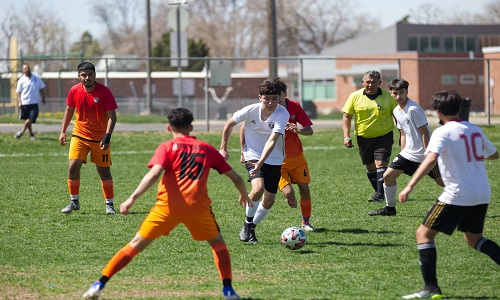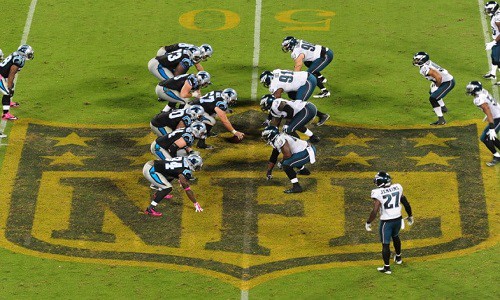Perhaps most of us know and have used the word offside. But not everyone understands the offside rule as well as its concept in professional soccer. So, do you know the soccer offside rule? How are soccer offsides explained?
Offside occurs when a player receives the ball under the opposing team’s defense. It is when only the opposing team’s second-last opponent is in front of him.
In this article, Langley Rams will provide you with helpful information. Let’s check it out!
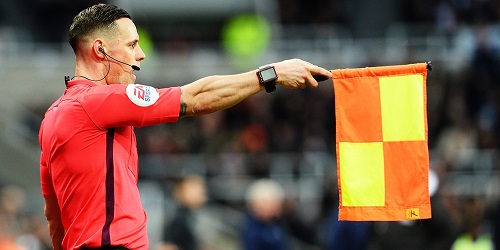
Offsides in soccer
Contents
What Is Offsides in Soccer?
A player is in an offside position if any parts of his body (except arms or hands) touch the ball directly; nearer to his opponents goal line than both the ball and the second-last opponent.
1. Purpose of The Offside Rule
The offside law is the 11th rule in the soccer rules published by FIFA. The aim is to ensure the fairness and thrill of the soccer match. It also helps promote the development and diversity of gameplay in modern soccer.
View more: Soccer Ball Size By Age: How To Choose Appropriate Soccer Ball Size
2. Fifa Regulations on Offside in Soccer
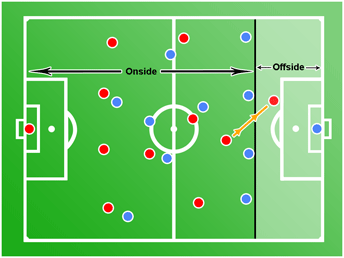
Offside position
Following the FIFA – Fédération Internationale de Soccer Association’s offside law:
A player will not be “flagged” for offside if he is in an offside position but receives the ball from a deliberate block or return pass.
There were specific changes in Law 11 of the FIFA offside rule in 2013 to make the offside rules fairer and stricter.
Accordingly, a player in an offside position can only participate in the ball pass when the opposing team pays attention to the ball pass.
The referee can still call offside in case:
- The opposing team accidentally let the ball touch the hand
- The attacker receives the ball in an offside position.
Besides, FIFA’s offside rule also clearly states that: A player will be in the offside offence if:
- Get involved in active play.
- Interfering with an opponent in terms of movement or vision.
- Have effects that impact the opponent’s ability to defend and contest the ball in an offside position.
This video also gives more details about offside in soccer.
How to Determine Offsides?
Linesman and VAR are two main factors determining offsides.
1. Linesman
The line referee will usually be the person responsible for observing and catching the offsides of the players. The position of the referee is along the touchline, so he has a favorable and accurate view. He can let decisions flag offside.
When a player is “called” for offside, the only penalty is to return the ball to the opposing team. It is a free kick at a fixed offside position in their half of the field.
2. VAR Technology
**VAR stands for Video Assistant Referee.
The way of the players is getting faster and better. Therefore, there are many cases where the situation happens so quickly and unexpectedly that the line referee may not observe in time. Consequently, he can make wrong decisions that are detrimental to the outcome of the game.
To overcome this, people have used VAR technology. It is an advanced technology to assist referees in detecting offside situations. This technology also helps a lot in all controversial cases between the two teams.
The VAR technology helps those who balance the game to make the most accurate and fair decisions.
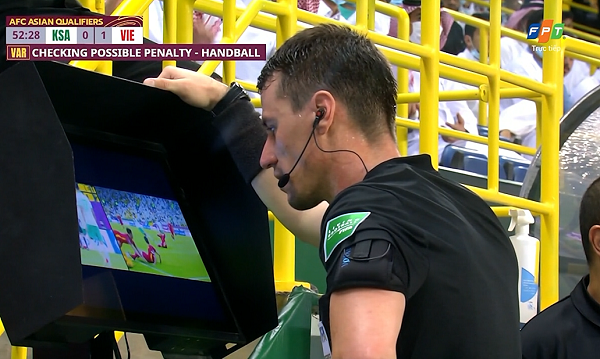
VAR helps referees in detecting offside situations.
Offside Situations in Soccer
When participating in a game, a player is “considered offside” if he commits the following four conditions:
- That attacking player stands on the opponent’s field of play.
- In that situation, there must be two fewer opponent players standing between him and the. opponents goal line than the ball.
- Receiving the ball
- Or prevent an opponent from joining the ball.
- The player stands in front of the ball (in the direction of the attack).
A player who is “determined” to be in an offside position when all of the above conditions are “met” is only penalized and considered offside when:
- At the moment his teammates pass the ball to him.
- He touches the ball.
- Become involved in active play at the offside position.
- Interfering with an opponent at the offside position.
- Gaining an advantage at the offside position.
Situations That Players Are Not Offside
Under what circumstances will a player not commit an offside foul?
- The player is in his half of the field of play.
- The attacking player has no part (head body or feet) nearer to the opponent’s goal than the last defender (not including the goalkeeper).
The player has taken an offside position with the four conditions mentioned in the previous section. But he does not participate directly or indirectly (preventing an opponent) on the ball. If so, even though he is already in the position of offside, he will not be “penalized.”
In some cases specified below, a player is already in an offside position and still participates in a dispute but will not be “penalized”:
- Receive the ball from a corner kick.
- Receive the ball directly from a throw goal kick.
- Receive the ball directly from a goal kick.
What Happens if a Player Is Offside?
All soccer players are thoroughly taught about the rules as well as understand the offside. However, in some cases, they can still get it due to many factors.
And for any offside, the referee will issue a penalty that the opposing team will receive an indirect free kick at the place where the error occurred.
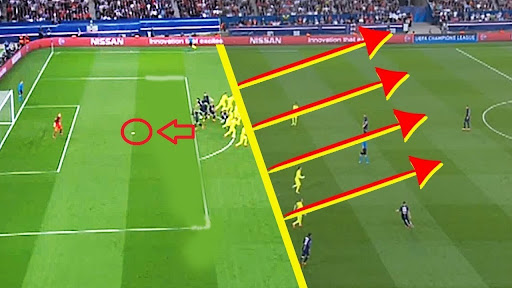
The opposing team will receive an indirect free kick offside position.
How to Break the Offside Trap in Soccer?
Normally, defenders will not stand too close to the goal. Instead, they will stand a little above the position of the opposing striker to “trap” that striker.
Knowing this, strikers need to understand how to break the offside trap.
1. Method 1
The attacking players must always be in front of the opposing defender relative to the touchline to break the offside trap. They just need to stand a little above the opposing defender. When a teammate has just kicked the ball, the striker immediately moves quickly past the defender to receive the ball and score.
2. Method 2
There is also another very effective way to break the offside trap. It is usually the case when the strikers find themselves in an offside position.
When teammates pass the ball at close range, they will not receive the ball. Instead, they signaled the player who passed the ball to them to continue running down and finishing. This way is the most comprehensive way to break the offside trap and easily fool the defenders.
3. Tips
In addition to agility and good movement, players need to equip individual skills to finish the attack effectively.
Samuel Eto’o is one of the great names of speed and finishing ability. Positioning ability is the ability of players to wriggle through the gaps of the opponent’s defence.
The better the positioning ability, the more chances a player will have to stand in an easy-to-receive area. Or he can create the most assists for his teammates.
However, be careful because sometimes “breaking the offside trap” also causes the player to fall into the state of “sticking for offside.” It happens when he doesn’t react in time and gets past the opponent’s last defender.
Significant gaps will make strikers mistake them for opportunities. But the reality is not.
In short, breaking the offside trap is when the strikers will move to the back and choose an opportunity to cross. It made the defense unable to turn back.
If any, the remaining strikers (if any) will stand in place to put pressure on the opponent’s defense. However, knowing how to break the offside trap means you can move quickly. Breaking the offside trap must also be “based” on the opponent’s tactics.
Final Thoughts
Langley Rams provides you with helpful knowledge related to offside in soccer.
Many violations occur during a soccer match, whether it is professional soccer. Soccer players must always know the soccer rules.
Soccer players need to have a good mix of good techniques with an understanding of errors in soccer. That will help the player play without being “fouled,” especially soccer offsides.


